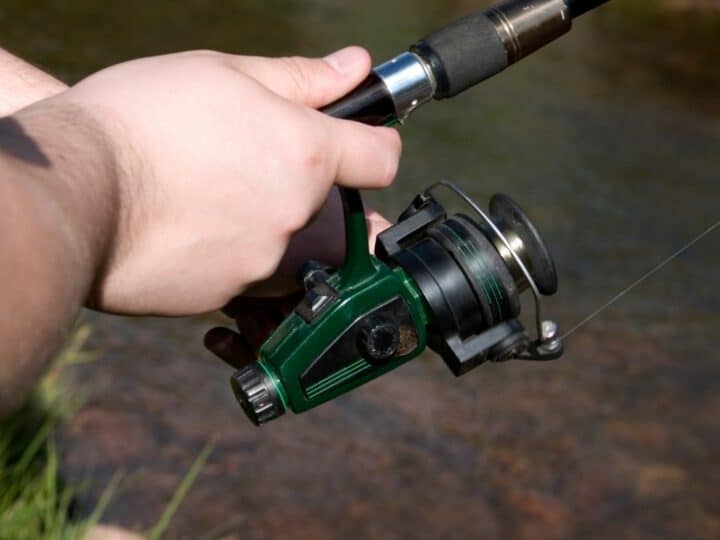Fishing reels and fishing lines go like sauce and spaghetti. If one is off, it doesn’t matter how great the other one is, the entire meal is spoilt.
It’s much the same with fishing reels that will not reel in. One or more of five major issues is probably affecting the reel.
If you want to know what’s causing such a problem, I’ll show you how to check for both conditions and fix the one that’s gone wrong.
How to Fix a Fishing Reel that won’t Reel In
If the fishing line is twisted, untangle it. If the braided fishing line is slipping, use electric tape or monofilament backing. If the cast bail mechanism is misaligned, correct it. If the reel is stuck, unjam it. If the fishing line isn’t where it should be under the bail’s arm, reset it.
Tangled Fishing Line
Tip: First, try to fix your tangled line by cutting away the messed-up length, otherwise you might lose a lot of expensive fishing line.
Begin by pulling out the line until you reach the first knot of tangles. Grip the reel tightly and firmly press down with your thumb on the spool.
Turn the reel until the spool spins.
Now pull out the line again until you get to the next kink and repeat the process until you’ve untangled the knot. It’s possible you’ll need to make several attempts in getting rid of a single knot.
Once one knot has been removed, keep going to the next knot, and the next, until the entire line is clear.
Braided Line Slippage on the Spool
Braided line slippage on aluminum surfaces is a common problem that can get quite serious if you use spinning reels.
When it goes wrong, the entire line coil just spins around the spool, making retrieval of the line by turning the reel impossible.
Tip: Despite the preceding paragraph, braided lines are suitable for spinning reels.
You just have to be careful to spool braided lines with the proper backing or preventative measure, which I will discuss in the next paragraph.
There are two methods to prevent braided fishing line slippage off a spool.
The simplest method is to place electrical tape on the surface of the spool before you tie the braided line to it. Braided lines don’t slip on electrical tape.
In essence, you are making your spool ready to handle braided lines by using electric tape.
The second you can do is to spool monofilament backing. (You will need between 50 and 100 yards of backing).
When done, tie the backing to the braided fishing line.
The Reel’s Cast Bail Mechanism is Misaligned
Examine the cast bail to see if it is properly aligned. The cast bail is usually a hard semi-circle wire attached to the ends of the spool.
It can also be a lever attached to a thumb switch.
Check the cast bail for any snagged lines. Snagged lines can easily cause severe problems for the reel, and even a single strand can prevent the reel from working correctly.
If you find any kinks, gently untangle the line and then try reeling in the line.
Squeeze the cast bail and take out both its ends from their housing. Carefully inspect the cast bail to confirm that the bail isn’t bent or distorted in any way.
If all is well, squeeze it again and place both ends back in their housing. When you replace the bail, verify that it is properly aligned.
Test to see if the bail now works as expected.
The Reel is Jammed Tight
This problem usually happens to saltwater spinning reels that don’t have the technology to seal the reel. The issue occurs most frequently when such reels have been exposed to salt spray or even submerged in saltwater.
What happens is, as it dries, the saltwater leaves small salt deposits on the reel’s ball bearings, gears, and other internal bits and pieces.
Tip: Any type of reel can suffer this problem if sand or dirt gets in among the reel’s delicate mechanisms, so do try to keep your reel as clean as possible.
To fix a blocked spinning reel, follow these steps:
- Disassemble the reel completely.
- Clean all its internal bits and pieces.
- Grease its gears and add oil and grease where needed.
Important: Use the correct grease and oil only! If you don’t know which grease and oil to use, see the next tip. - Carefully reassemble the reel.
Tip: Don’t attempt this if you are a beginner. It can be tricky to reassemble the reel afterward.
If you’re new to all this, my advice is to let a professional clean it instead of trying to fix it yourself.
The Line isn’t where it should be Under the Bail’s Arm
New fishermen sometimes forget to run their lines under the bail arm when setting up their rod and reel. If you are a new fisherman yourself, it’s possible you made this same mistake as well.
If you did, the line won’t wrap around the spool, and diddlysquat will happen when you turn the reel’s handle.
Fortunately, this issue is easy to fix.
Loosen the drag knob that’s atop the spool and take the spool out from the spinning reel. Next, open the bail and return the spool.
This time, when you close the bail arms, the line will run underneath it, and you’ll be able to reel in the line without difficulty.
Frequently Asked Questions about How to Fix a Fishing Reel that won’t Reel In
Why does my fishing line keep getting tangled up?
Slack fishing lines constantly show up as the main reason fishing reels can get stuck. Slack lines create loose loops on the spool as soon as you start reeling in the line. These loose loops will slide off the reel and overlap during casting, inevitably leading to entanglement.
Is it possible for me to put my fishing lines on backward?
Absolutely. No problem. Modern fishing reels have anti-reverse mechanisms (or ‘clutches’) that enable fishermen to put fishing lines backward. This detail permits the reel to rotate in either direction without difficulty.
Afterword: How to Fix a Fishing Reel that won’t Reel In
Tangled fishing lines and broken reels quickly spoil what might otherwise be a splendid day on the water. As detailed above, there are simple solutions to these problems.
However, fixing problems is inferior to avoiding them in the first place.
Problem-free fishing involves an investment from you in the form of maintenance. Constantly scrutinize your fishing lines, rods, and reels.
Bookend and intersperse all fishing trips with equipment maintenance. Make a habit of doing this, and you will be rewarded with years of untroubled fishing.

